Chicken fried rice is a tasty dish that many people love. You often see it on Chinese takeout menus, but it is easy to make at home too. It has soft chicken pieces, fluffy rice, fresh vegetables, and sauces that give it lots of flavor. Each bite is delicious and satisfying.
This dish is great for busy weeknights. I remember evenings when I had very little time to cook, and making chicken fried rice with leftover rice and chicken saved the day. It is fast to cook, easy to change with any vegetables you have, and does not need special ingredients.
Chicken fried rice is also very flexible. You can make it simple with soy sauce and eggs, spicy with a little sriracha, or add sweetness with hoisin sauce. This makes it perfect for anyone who wants a quick and yummy dinner at home.
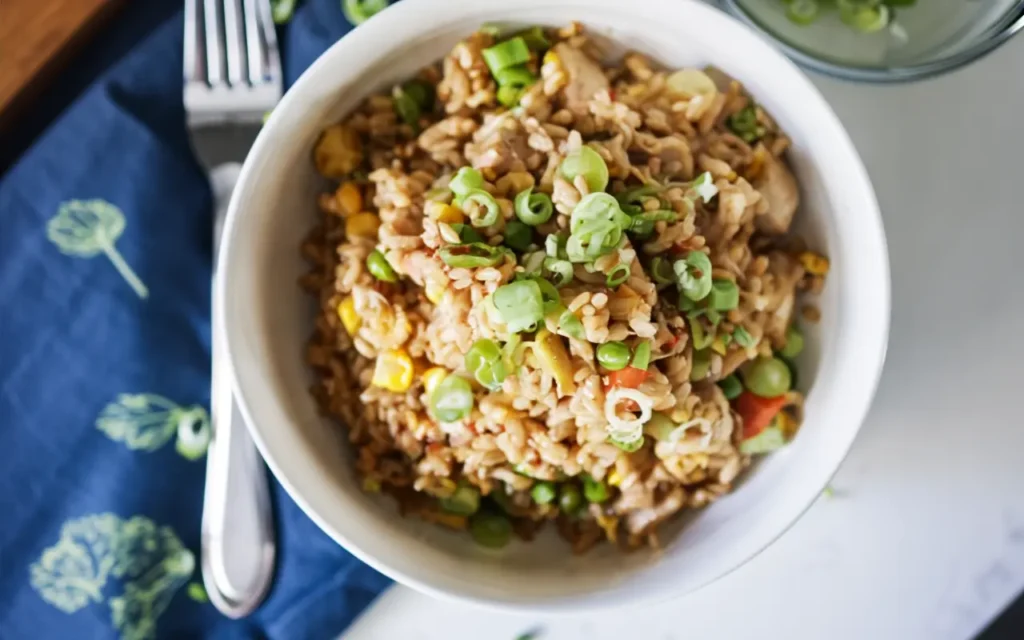
Ingredients You’ll Need
Rice
The type of rice you use makes a big difference in fried rice. Day-old rice works best because it is drier and does not clump when frying. Jasmine rice and long-grain rice are great options because they stay fluffy and separate nicely. I often use leftover rice from the night before—it makes cooking faster and gives the fried rice a perfect texture.
Chicken
You can use either chicken breasts or thighs, depending on your taste. Breasts are leaner, while thighs are juicier and more flavorful. Before adding the chicken to your fried rice, cook it first by boiling, grilling, or sautéing. I like to lightly season the chicken and sauté it in a bit of sesame oil; it adds extra flavor to the rice.
Vegetables
Vegetables bring color, crunch, and nutrition to your fried rice. Popular choices include carrots, peas, bell peppers, onions, and corn. You can also mix in other vegetables you like, such as broccoli or zucchini. Fresh or frozen vegetables both work, but add frozen vegetables directly to the pan without thawing for quick cooking.
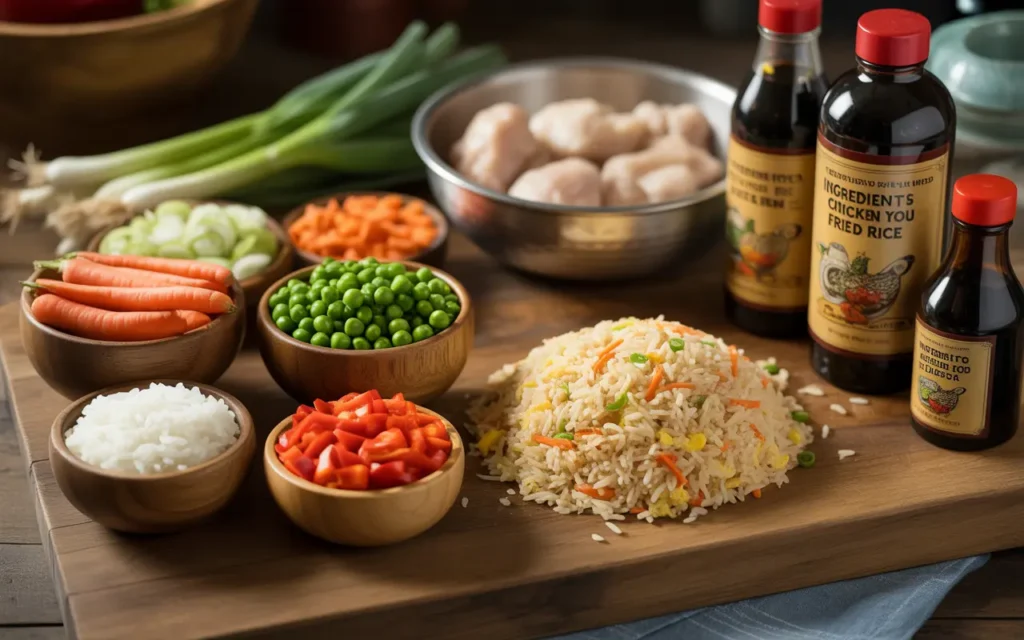
Sauces and Oils
The sauces and oils give fried rice its signature taste. Soy sauce is classic, oyster sauce adds depth, and sesame oil gives a nutty aroma. If you like a little heat, a touch of sriracha works perfectly. I always keep these sauces handy because they let me customize flavor easily.
Eggs and Extras
Eggs are a key ingredient that adds protein and texture. You can scramble them separately or mix them in with the rice. Extras like garlic, green onions, or even crispy bacon make the dish more flavorful. In my experience, adding green onions at the end gives a fresh pop that balances the savory taste.
Step-by-Step Cooking Instructions
Preparing the Rice
Using day-old rice is the secret to perfect fried rice. If you don’t have leftover rice, cook fresh rice and let it cool completely before frying. Cold rice separates easily and won’t turn mushy in the pan. I often spread freshly cooked rice on a tray and put it in the fridge for 30–60 minutes; it works almost as well as leftover rice. This simple step makes the stir-fry process much easier.
Cooking the Chicken
Start by cooking your chicken before adding it to the rice. Sautéing or stir-frying the chicken in a hot pan with a little oil helps lock in flavor and keeps it tender. Make sure to cut the chicken into small, even pieces so it cooks quickly and mixes well with the rice. I like to season mine lightly with salt and pepper, which adds flavor without overpowering the dish.
Stir-Frying the Vegetables
Vegetables should be added in the right order to keep them crisp and tasty. Start with onions and carrots because they take longer to cook, then add peas, bell peppers, or any softer vegetables. Stir constantly to avoid burning and to coat the veggies with a little oil. I always keep the pan hot, which gives the rice and veggies a slightly smoky, restaurant-style flavor.
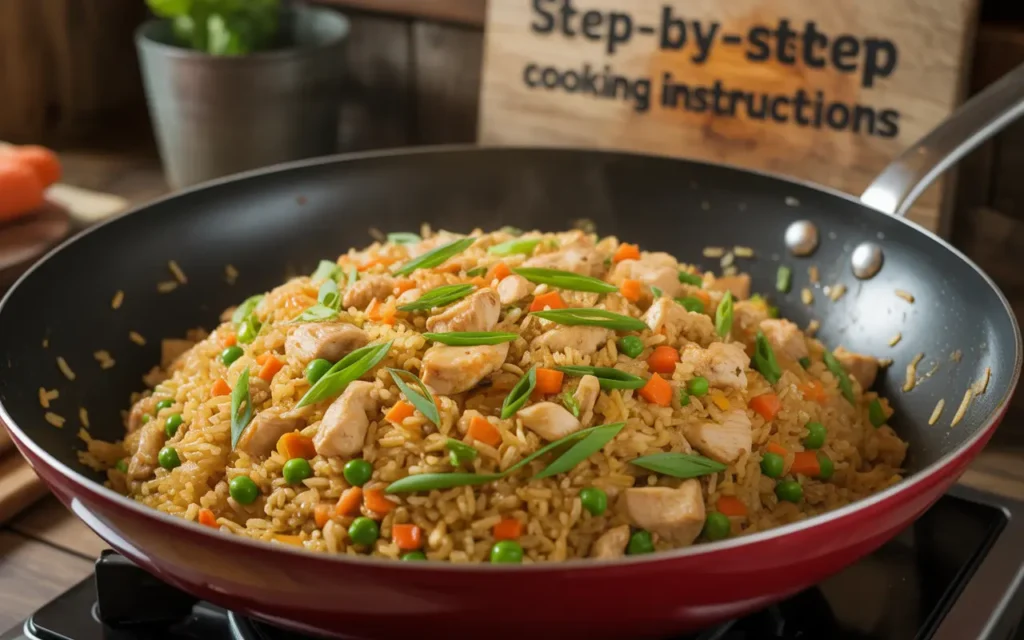
Combining Everything
Once the chicken and vegetables are cooked, add the rice, sauces, and scrambled eggs. Break up any clumps of rice and mix everything well so the flavors blend evenly. Using soy sauce, oyster sauce, or sesame oil at this stage ensures the fried rice is savory and aromatic. Personally, I drizzle a little extra sesame oil at the end—it adds a nutty aroma that makes the dish irresistible.
Final Touches
Finish by adjusting the seasoning with a little salt or pepper if needed. Garnish with chopped green onions, sesame seeds, or a sprinkle of fresh herbs to add color and freshness. These small touches make the dish look as good as it tastes. I always like adding green onions at the last moment—they stay bright and give a crisp texture to every bite.
Tips for Perfect Fried Rice
- Use day-old rice: Freshly cooked rice can be too soft and sticky. Let it cool completely or spread it on a tray to dry slightly before frying. This keeps the rice fluffy and separates the grains.
- Cook on high heat: High heat helps sear the ingredients and gives a restaurant-style “wok-fried” flavor. Stir constantly to prevent burning and cook everything evenly.
- Quick stir-fry: Work fast when frying rice, chicken, and vegetables. Quick cooking preserves the texture of veggies and prevents the rice from becoming mushy.
- Customize your proteins: Swap chicken for shrimp, tofu, or beef depending on your preference. Cutting proteins into small, even pieces ensures they cook quickly.
- Add vegetables in order: Harder vegetables like carrots and onions go first; softer ones like peas and bell peppers go later. This keeps all veggies crisp and colorful.
- Experiment with flavors: A little sesame oil, soy sauce, or optional spices can turn simple fried rice into a unique, tasty meal.
Variations of Chicken Fried Rice
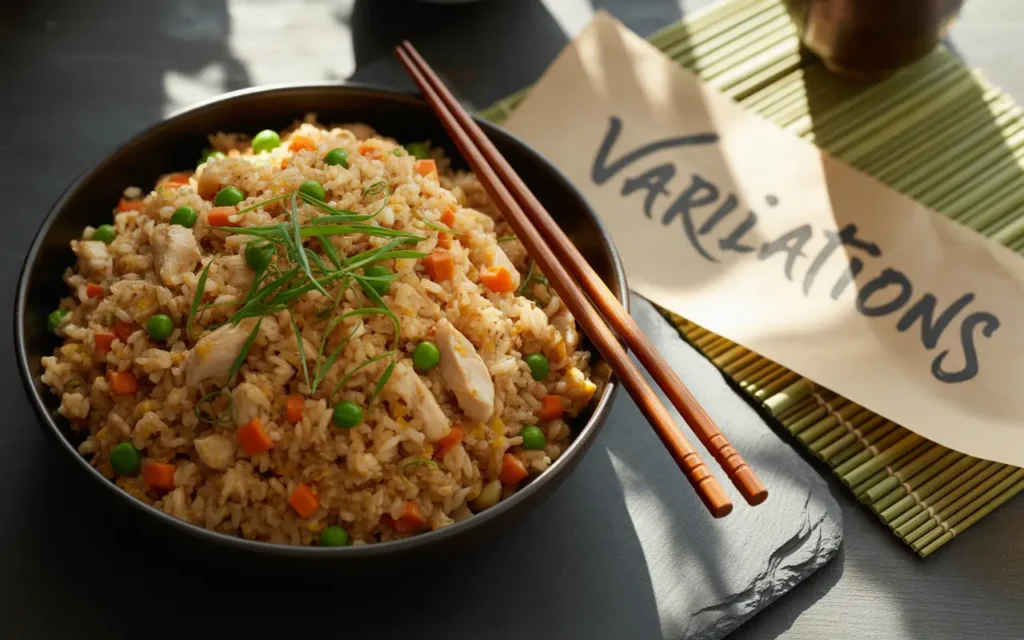
Restaurant Style
Restaurant-style chicken fried rice is richer in flavor and often has extra ingredients like shrimp, bacon, or a variety of vegetables. The key is to cook everything on high heat in a hot wok or pan, which gives it a slightly smoky, “wok hei” taste. I like to add a splash of soy sauce and sesame oil at the end—it instantly makes the fried rice taste like it came from a restaurant.
Healthy Version
For a healthier twist, you can swap white rice for brown rice or even cauliflower rice. Brown rice adds fiber and nutrients while still giving you a chewy, satisfying texture. I sometimes use cauliflower rice when I want a low-carb version; it cooks quickly and absorbs all the flavors of the sauces and vegetables. Adding plenty of colorful vegetables like bell peppers, peas, and carrots keeps it nutritious and filling.
Spicy Version
If you love heat, a spicy version is perfect. You can add chili flakes, sriracha, or a little hot sauce to the rice while stir-frying. I usually add sriracha toward the end and mix it gently, so the spice blends evenly without overpowering the other flavors. A touch of spice gives the fried rice an exciting kick that makes it irresistible.
Quick Microwave Version
When time is tight, you can even make fried rice in the microwave. Mix cooked rice with pre-cooked chicken, vegetables, and a small amount of soy sauce in a microwave-safe bowl. Heat in short intervals, stirring in between, until everything is warm and well combined. I use this trick on busy days—it’s not exactly restaurant style, but it’s fast, easy, and still tasty.
Common Mistakes to Avoid
- Overcooking rice or chicken: Rice that is too soft becomes mushy, and chicken that cooks too long turns dry. Using day-old rice and cooking chicken just until tender keeps the texture perfect.
- Adding too much sauce: Too much soy sauce, oyster sauce, or sesame oil can make the fried rice salty or watery. Start with a small amount and add more as needed to keep the flavors balanced.
- Frying at too low heat: Low heat can make vegetables soggy and rice sticky. High heat ensures a quick stir-fry, keeps the chicken tender, and gives a slightly smoky, restaurant-style flavor.
Serving Suggestions
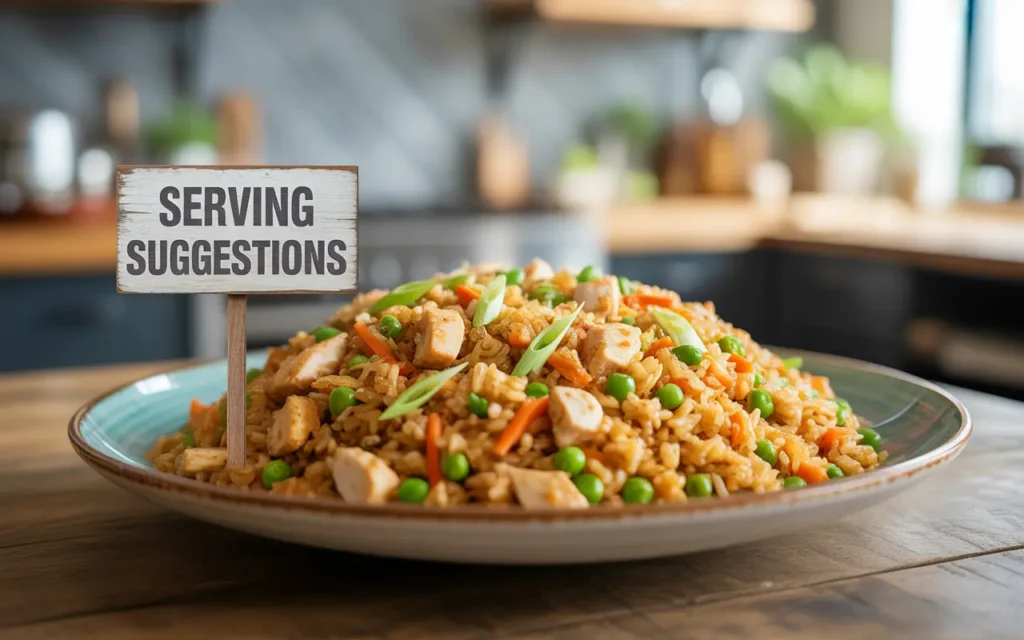
Chicken fried rice pairs wonderfully with other simple dishes to create a complete meal. Popular options include spring rolls, dumplings, or a light soup like hot and sour or egg drop soup. These sides add different textures and flavors that complement the rice, making your meal more exciting and balanced. I often serve fried rice with crispy spring rolls at home—it turns a quick dinner into something special.
For drinks, light beverages like iced green tea, lemonade, or sparkling water work best. They help refresh the palate and balance the savory flavors of the fried rice. In my experience, a chilled drink makes a simple homemade meal feel like a restaurant experience.
You can also pair fried rice with other small dishes like steamed vegetables, pickled cucumbers, or sautéed greens. These sides add color, nutrition, and extra flavor without overwhelming the main dish. This way, the meal looks great on the table and tastes delicious with every bite.
Storage and Reheating Tips
- Store in the fridge: Keep chicken fried rice in an airtight container for 3–4 days to stay fresh. Label the container with the date for easy tracking.
- Freeze for longer storage: Use a freezer-safe container to store fried rice for up to a month. This is great for meal prep or busy days.
- Reheat on the stovetop: Add a small splash of water or oil and stir-fry over medium-high heat. This keeps the rice fluffy and vegetables crisp.
- Reheat in the microwave: Spread the rice evenly in a microwave-safe dish, cover loosely, and heat in short intervals, stirring in between. Add a little soy sauce or sesame oil to refresh the flavors.
- Tips for best texture: Avoid over-heating, as it can make rice mushy. Quick, even heating preserves the chicken, vegetables, and overall taste.
FAQs ( Frequently Asked Questions)
Can I make it vegetarian?
Yes! You can easily make chicken fried rice vegetarian by skipping the chicken and adding extra vegetables or tofu. I often use bell peppers, peas, carrots, and mushrooms to make it hearty and colorful. Adding scrambled eggs or a plant-based protein can also give it more texture and flavor while keeping it filling.
Can I use frozen vegetables?
Absolutely. Frozen vegetables are convenient and work well in fried rice. Just add them directly to the pan without thawing, and stir-fry on high heat. I personally use frozen peas and corn on busy nights—they cook quickly and keep the dish colorful and tasty.
How to make it healthier?
To make fried rice healthier, use brown rice or cauliflower rice instead of white rice. You can also load up on vegetables and reduce oil or sauce. I like adding fresh herbs and a little sesame oil at the end for flavor without extra calories. Choosing lean protein like chicken breast or tofu also makes it nutritious.
Can I prepare it in advance?
Yes, chicken fried rice is great for meal prep. Cook it, let it cool, and store it in an airtight container in the fridge for up to 3–4 days. I often make a double batch on weekends—it saves time during busy weekdays and tastes almost as good when reheated properly.
Conclusion
Chicken fried rice is an easy, quick, and flexible meal that works well for busy nights. With simple ingredients like rice, chicken, vegetables, and sauces, you can make a dish that is tasty and filling. I often cook it when I need a fast dinner, and it always feels comforting and satisfying.
Whether you make the classic version or try a healthy, spicy, or restaurant-style variation, chicken fried rice is always a winner. With a few tips for cooking, storing, and reheating, you can enjoy it anytime. It’s a fun dish to personalize and one of the best quick dinner ideas you can make at home.
